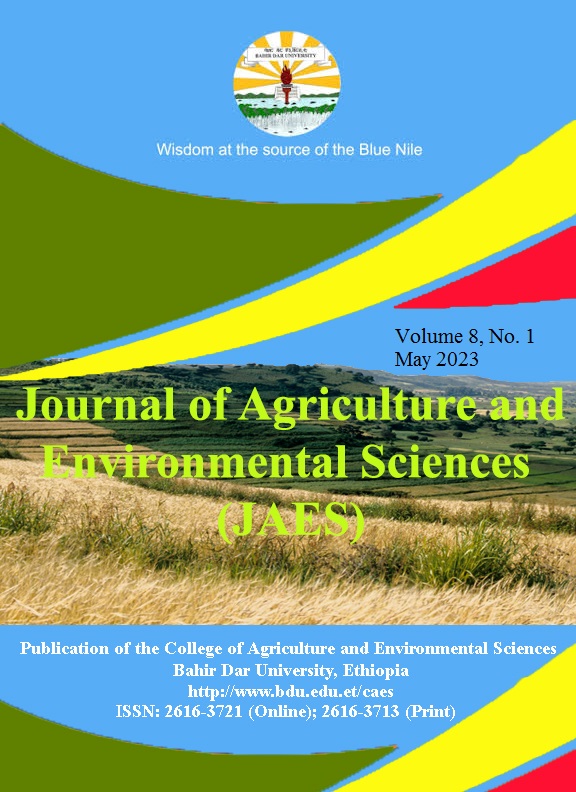Dry matter accumulation dynamics, morphological characteristics and nutritive value of desho (Pennisetum glaucifolium) grass varieties in the central Highlands of Ethiopia
Abstract
Desho (Pennisetum glaucifolium) grass is one of the indigenous cultivated multipurpose perennial forage crops grown for animal feed and soil conservation practices in Ethiopia. This study was conducted to evaluate desho grass varieties for their morphological characteristics, dry matter yield performance, and nutritive value in the central highlands of Ethiopia. The study was conducted at Holetta Agricultural Research Center during the main cropping seasons of 2013 - 2017 under rain fed conditions. Four varieties of desho grass, viz. Areka (DZF # 590), Kulumsa (DZF # 592), Kindu Kosha-1 (DZF # 591), and Kindu Kosha-2 (DZF # 589) were planted in a randomized complete block design with three replications. Though the plant height of desho grass varieties was not significant (P>0.05) at each production year and combined over years, it significantly differed among the production years. The number of nodes per plant and leaf to stem ratio varied significantly while the internode length was not significant among desho grass varieties. The combined over years analysis indicated that the leaf and stem dry matter yields varied significantly (P<0.05) for desho grass varieties. Furthermore, the leaf and stem dry matter yields differed significantly among the production years. The total dry matter yield accumulated by desho grass varieties varied significantly and Areka (DZF # 590) variety accumulated the highest dry matter yield (23.8 t/ha) followed by Kulumsa (DZF # 592) variety (23.1 t/ha), while Kindu Kosha-1 (DZF # 591) accumulated the least (18.8 t/ha) dry matter yield. The first year of production produced the lowest dry matter yield while the accumulation of dry matter yield increased for consecutive production years but the yield declined in the last production year. The highest dry matter yield was accumulated in the 2016 production year and it had 19.8 and 4.3% advantages over the 2014 and 2015 production years, respectively. The crude protein yield and nutritive value among desho grass varieties was not significant. The result indicated that the crude protein yield of desho grass varieties ranged from 2.8 to 4.0 t/ha with a mean of 3.4 t/ha. Similarly, the crude protein content ranged from 10.7 to 12.5% with a mean of 11.7%. Generally, the varieties have comparable performances for measured traits in the study area. However, further study should be conducted over locations and years to select and recommend the best variety for the study area and to other similar agro-ecologies.
Copyright (c) 2023 Journal of Agriculture and Environmental Sciences

This work is licensed under a Creative Commons Attribution-NonCommercial-NoDerivatives 4.0 International License.
Authors who publish with this journal agree to the following terms:
- Authors retain copyright and grant the journal right of first publication with the work simultaneously licensed under a Creative Commons Attribution License that allows others to share the work with an acknowledgement of the work's authorship and initial publication in this journal.
- Authors are able to enter into separate, additional contractual arrangements for the non-exclusive distribution of the journal's published version of the work (e.g., post it to an institutional repository or publish it in a book), with an acknowledgement of its initial publication in this journal.
Authors are permitted and encouraged to post their work online (e.g., in institutional repositories or on their website) prior to and during the submission process, as it can lead to productive exchanges, as well as earlier and greater citation of published work (See The Effect of Open Access).


